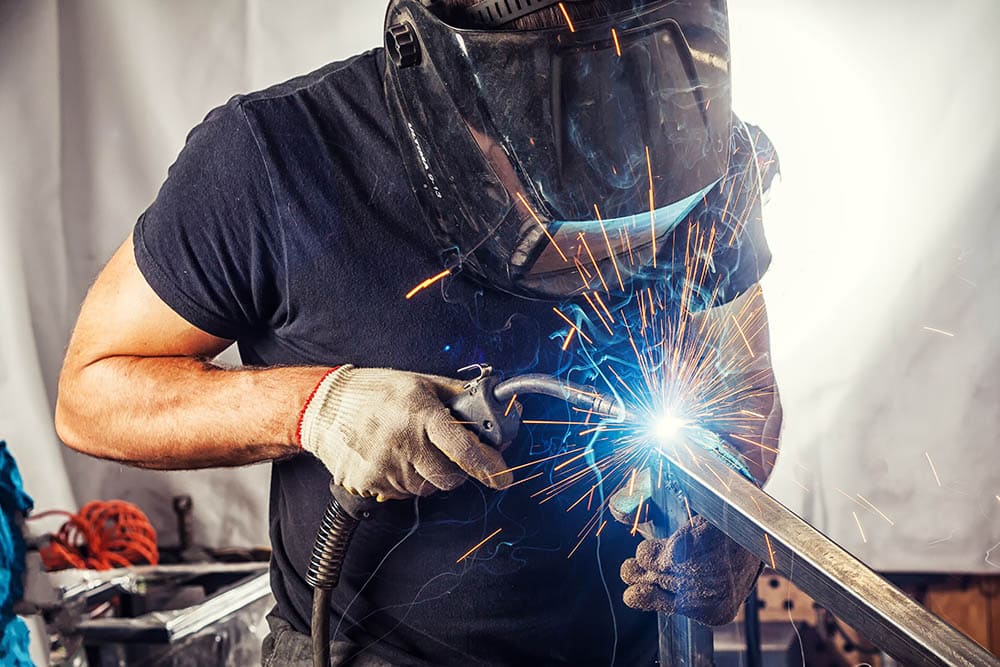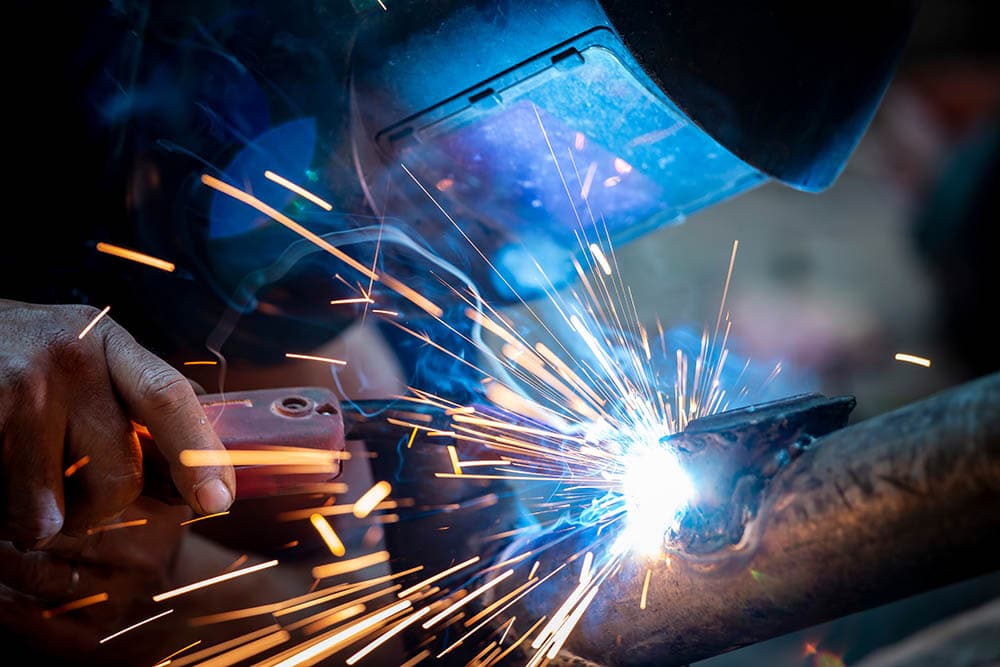8 Common Weld Symbols in the UK & How to Understand Them
Last Updated on

If you are working in the UK’s welding industry or aspiring to be one, it’s important to learn about the UK weld symbols and their meanings. If you’re interested in learning more about the standard weld symbols used by welders in the country, this article is for you!
A weld symbol helps you communicate your planned weld to another welder. You don’t have to explain what you’re doing every step of the way.
In this article, we’ll focus on the eight most common weld symbols used in the UK. Also, we’ll look at some components of a weld symbol. This way, you can get a feel for how you should use them. Let’s jump right in!
8 Common Weld Symbols
1. Single Bevel Groove Weld with Broad Root Face
| Type of Welding Joint: | Butt Joint |
| Welding Type: | Structural Steel Welding (SSW) |
This weld symbol represents a single bevel groove weld with a broad root face. It’s a weld joint with one side face being thicker than the other side face. The root face of the material is broad and flat, as opposed to narrow and sloping in other welds. It can also be slightly concave or convex. It depends on the type of steel you’re welding.
This weld symbol is commonly used for structural steel and other materials with high tensile strength. Also, you’ll find it when there are no stresses at right angles to the sheet metal’s plane.
The single bevel groove weld is used to join an edge to a flat surface. It is a butt weld and therefore has no undercut. Also, the weld pool produces the groove. It flows into the root opening created at the start of the weld by the electrode.
2. Single V Groove weld with Broad Root Face
| Type of Welding Joint: | V-shaped Butt Joint |
| Welding Type: | Shielded Metal Arc Welding (SMAW) |
The groove on the root face is wider than the groove on the side of the weld. It’s used when welding with a flat root face, which is common in many types of construction.
This symbol represents a SMAW process using a single V groove root face weld in butt or fillet welds. The letter “V” represents the profile of the groove root face. Also, it indicates that this is a groove weld with a broad root face.
The single V groove weld with a broad root face symbol is common on drawings for steel structures. You’ll also find it in piping or tanks where there is no need for specific information about the type of welding machine or electrode used. It can be used for either manual or mechanized welding processes.
3. A Spot Weld Symbol
| Type of Welding Joint: | Spot Weld Joint |
| Welding Type: | Spot Welding |
The spot weld symbol has two lines with a circle between them. The circle represents the surface of the metal you’re joining. On the other hand, the lines represent the two pieces of metal being welded together.
A spot weld is a small weld that holds two pieces of metal. It’s used to create a seam that’s not visible on the outside. Spot welds are commonly used when holding two flat pieces of metal together.
The spot weld symbol shows where the welder should place their gun when welding this type of welding joint. It indicates a spot weld joint, which is a continuous seam between two pieces of metal. It’s made by applying pressure and heat until the two pieces bond together.
This symbol is also used for connecting parts of machines such as gears and motors. You can also use it for connecting pipes in an industrial setting.
4. Fillet Weld
| Type of Welding Joint: | Tee Joint |
| Welding Type: | Gas Tungsten Arc Welding, Shielded Metal Arc Welding (SMAW), and Gas Metal Arc Welding (GMAW). |
The fillet weld symbol represents a weld made on a flat surface such as between two plates or sheets of metal. It’s formed using a single line with an arrow at each end. It points towards the base of the weld.
The arrow points from left to right if you’re looking at it from above. Also, it points from right to left if you’re looking down at it.
This type of weld makes a smooth transition between the two surfaces being joined together. It helps ensure that they stay flush against each other after joining them together through welding.
5. Plug/Slot Weld Symbol
| Type of Welding Joint: | Plug Weld Joint |
| Welding Type: | Plug Welds, SMAW, GTAW, and MMAW (Manual Metal Arc Welding) |
The plug weld symbol signifies a weld made using a plug and socket technique. The weld is formed by making a depression in the material using a chisel or a punch. The symbol is a square with an arrow pointing to the left. The arrow represents the direction of travel, while the square represents the area being welded.
This weld is helpful when repairing holes in sheet metal where there may be little room for welding on either side of the hole. It is often used together with fillet welding or butt welding symbols. It’s one of the most common symbols present for all welding processes.
6. Surfacing Weld Symbol
| Type of Welding Joint: | Edge Joints |
| Welding Type: | FCAW (Flux-Cored Arc Welding) |
This is the most common weld symbol that you will see on any welding project, especially in sheet metalwork and light fabrication work. It is used when welding at the surface of the metal. It does not penetrate through the material’s thickness.
The arrow indicates the direction of travel of the weld bead, while the arrowhead indicates the direction from which the heat source is applied.
This symbol shows two surfaces being merged. The wavy lines represent the weld bead.
The symbol also shows that the weld is made on one side. The other side will be grounded off.
7. Single U Groove Weld
| Type of Welding Joint: | Corner and Butt Joints |
| Welding Type: | Shielded Metal Arc Welding (SMAW) and Manual Metal Arc Welding (MMAW) |
This is a standard symbol used in the UK, showing a single arc with a vertical line. It represents a simple butt joint. There’s no gap between two pieces being joined together. This type of joint is used when joining two pieces of metal at right angles or parallel to one another.
The symbol describes a groove weld with one U-shaped groove. It also shows that an electrode wire should be inserted into both sides of the groove before fusion happens.
You can find this weld symbol on most drawings as a reference when drawing up welding procedures such as those for hot work and shielded metal arc welding (SMAW). The weld is commonly used for joining thick pieces of metal.
8. Backing Weld Symbol
| Type of Welding Joint: | Groove Weld Joints |
| Welding Type: | SMAW (Shielded Metal Arc Welding) |
The backing weld symbol denotes backing bars used during welding procedures. It’s helpful when welding thick materials where a backing bar is needed to reduce distortion while they cool.
The symbol identifies an area that needs a backing weld to be performed. It’s needed on any weld joint where there’s not enough metal thickness on one side of the joint to provide adequate support for welding.
The purpose of these welds is to distribute the forces evenly over the thickness of the material being joined. It also prevents cracking. Usually, backing bars are made of mild steel, but occasionally stainless steel or other materials are used.
Backing welds are sometimes needed when using electrodes with low melting points, such as aluminum. They prevent oxidation during welding.
Anatomy of a Weld Symbol
A weld symbol is a drawing that depicts a weld joint and its crucial information. Welding engineers and operators use these symbols to communicate with each other.
The symbols are also helpful for designers and manufacturers. Usually, they cross-check their designs using the weld symbols. This way, they verify if the weld joints they have created will fulfill the requirements they need to.
Here are several parts of a weld symbol.
An Arrow
The arrow is a crucial part of the weld symbol. It tells you which direction to weld. It is always pointing toward the area where you need to weld and away from the area that needs to be protected, such as a nut or a bolt.
Reference Line
The reference line is located above the symbol. This line helps you identify the type and size of the joint you’re welding and other information. It also identifies where to place welds. As well as see other components such as nuts and bolts. You may need them for assembly after completing welding operations.
A Leader Line
The leader line connects the arrow to the reference line. It can also be called a baseline, trace, or extend the line. It is always included when welding symbols are printed on materials, such as steel, aluminum, and stainless steel.
The Tail
The tail is the part attached to every weld symbol. It broadcasts special instructions. Usually, it is an optional component of a weld symbol.

Final Thoughts
Symbols are a universal language for all welders. They make an effective means of communication between all welders involved in the process. Understanding weld symbols is essential if you wish to pursue a career in the welding industry.
These weld symbols may seem complicated and intimidating, but they’re easy once you understand them.
Now is an excellent time to familiarize yourself with most of the common weld symbols used in the UK. It will make it easier for you to interpret them on site.
You may also be interested in: How Much Does Welding School Cost in the UK
Featured Image Credit: Everyonephoto Studio, Shutterstock
